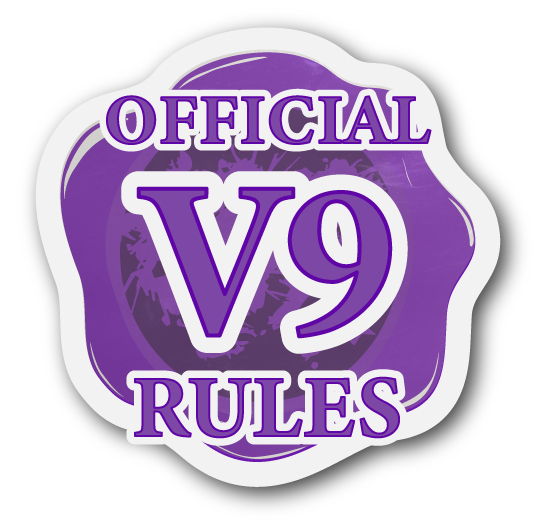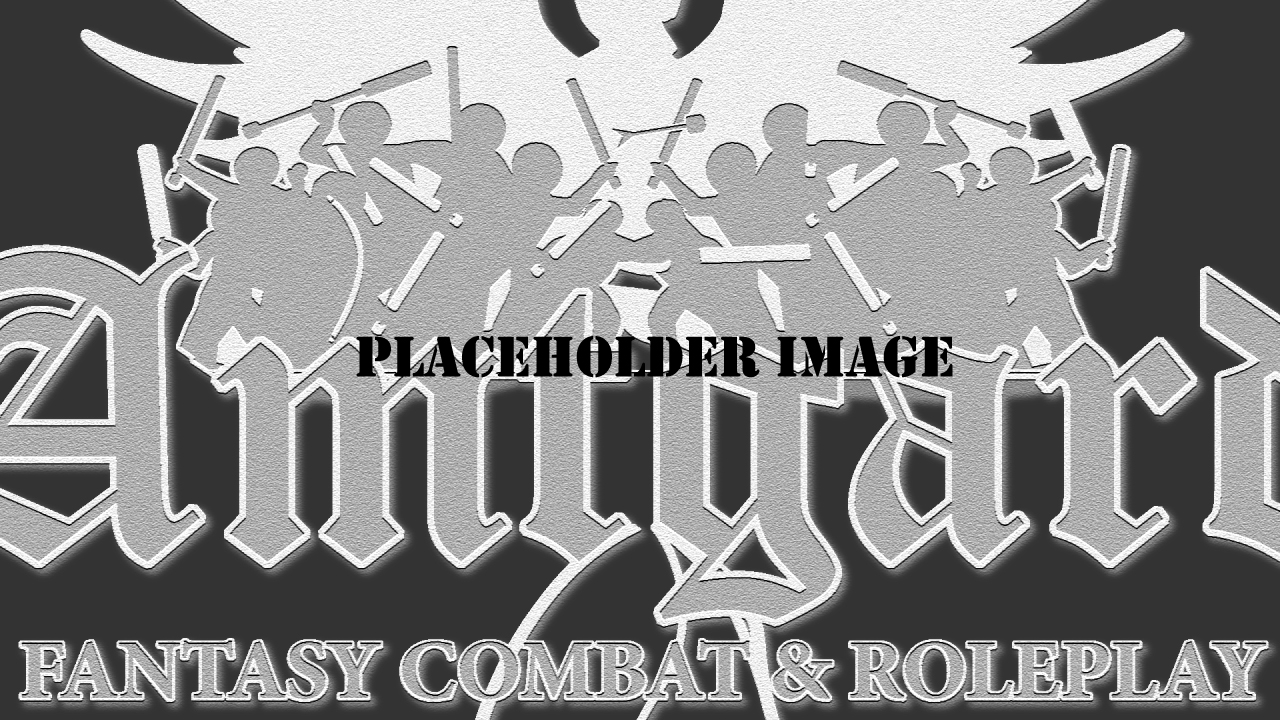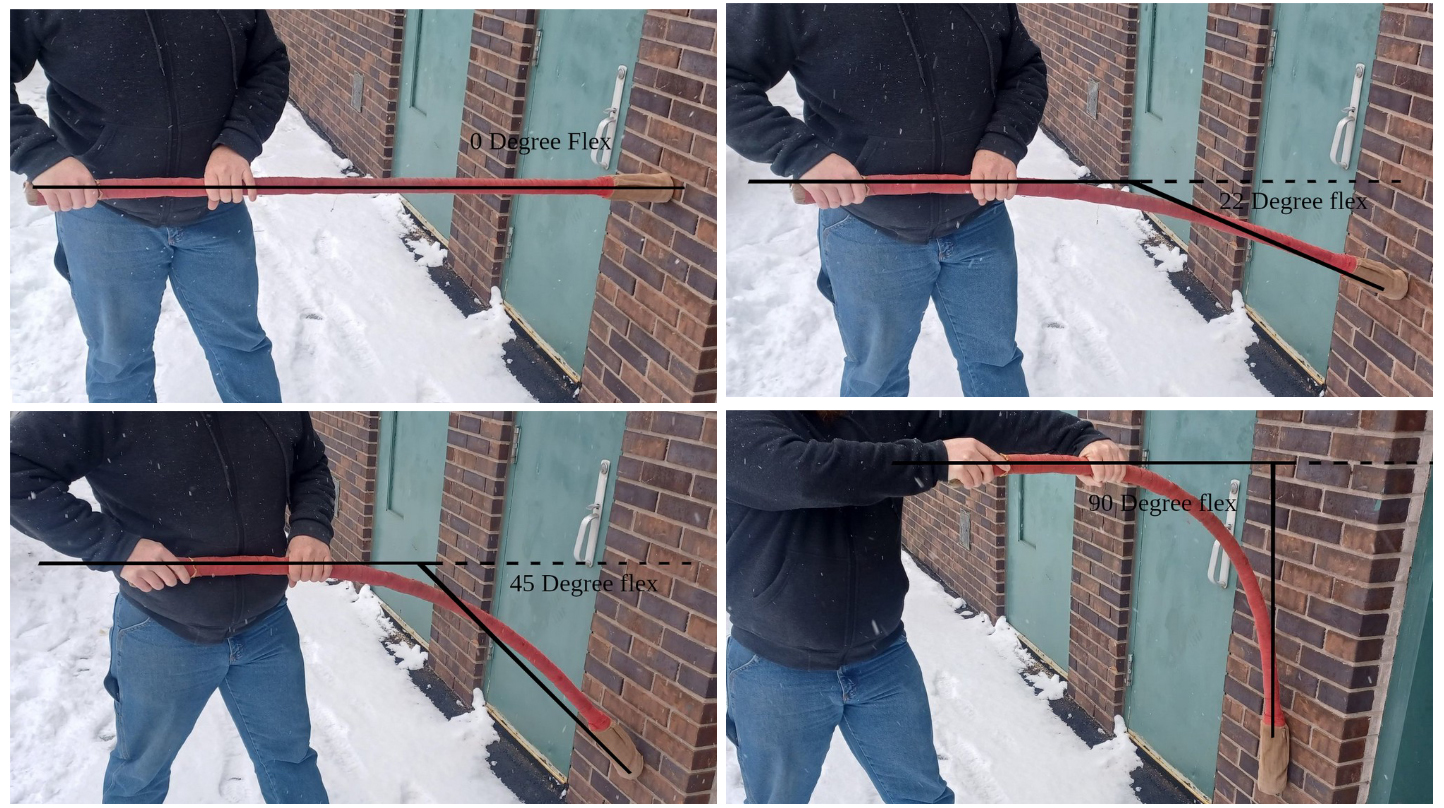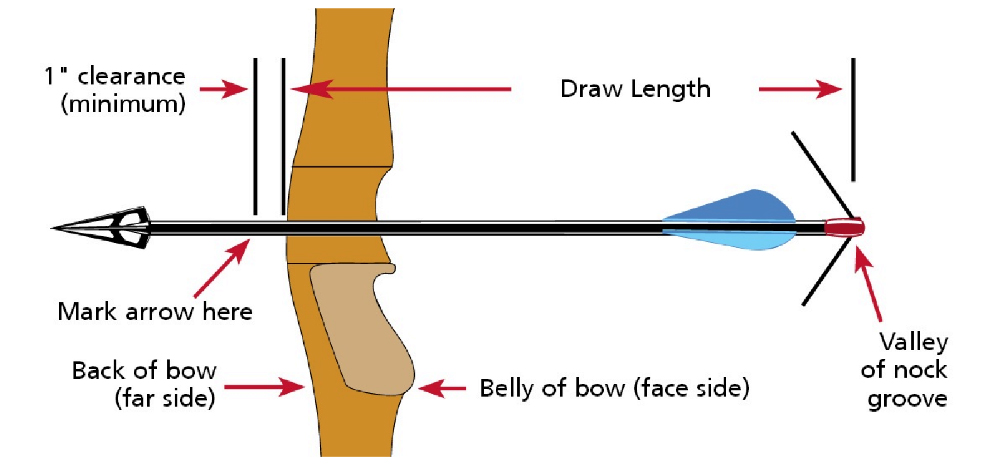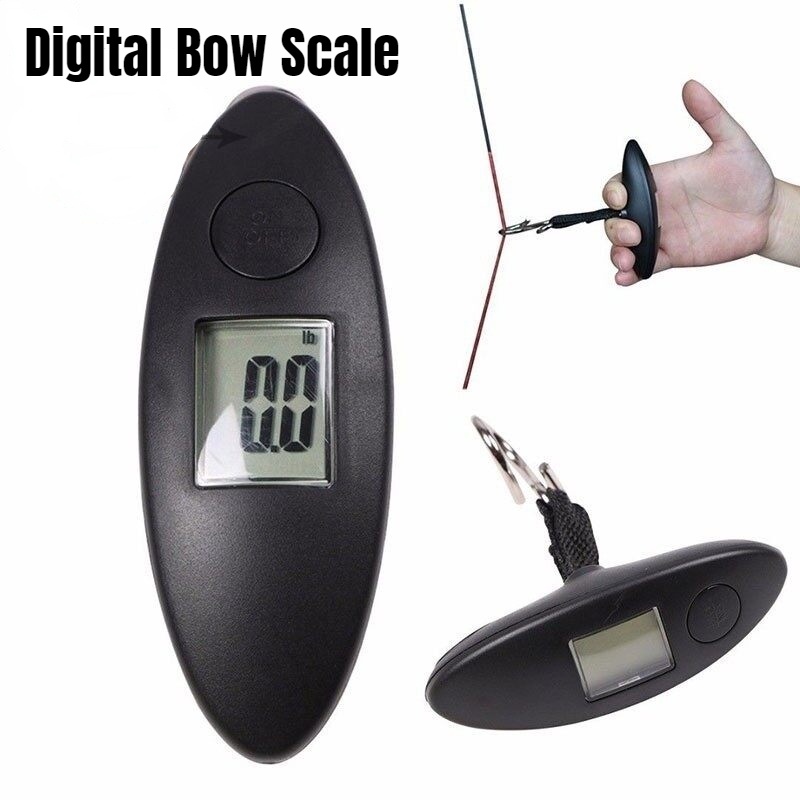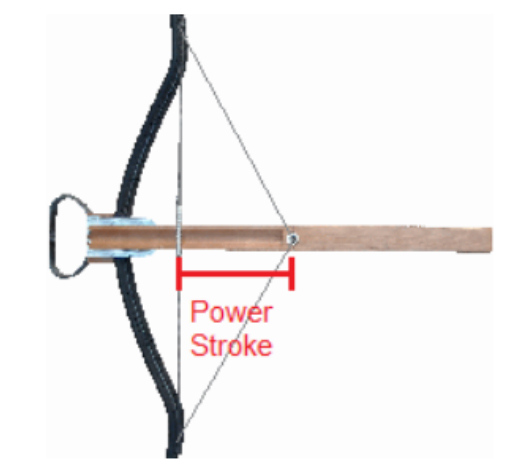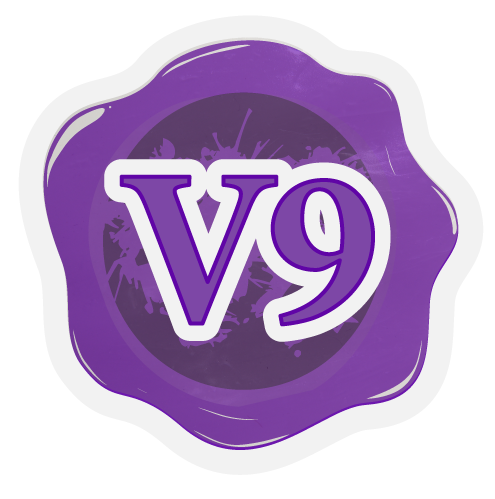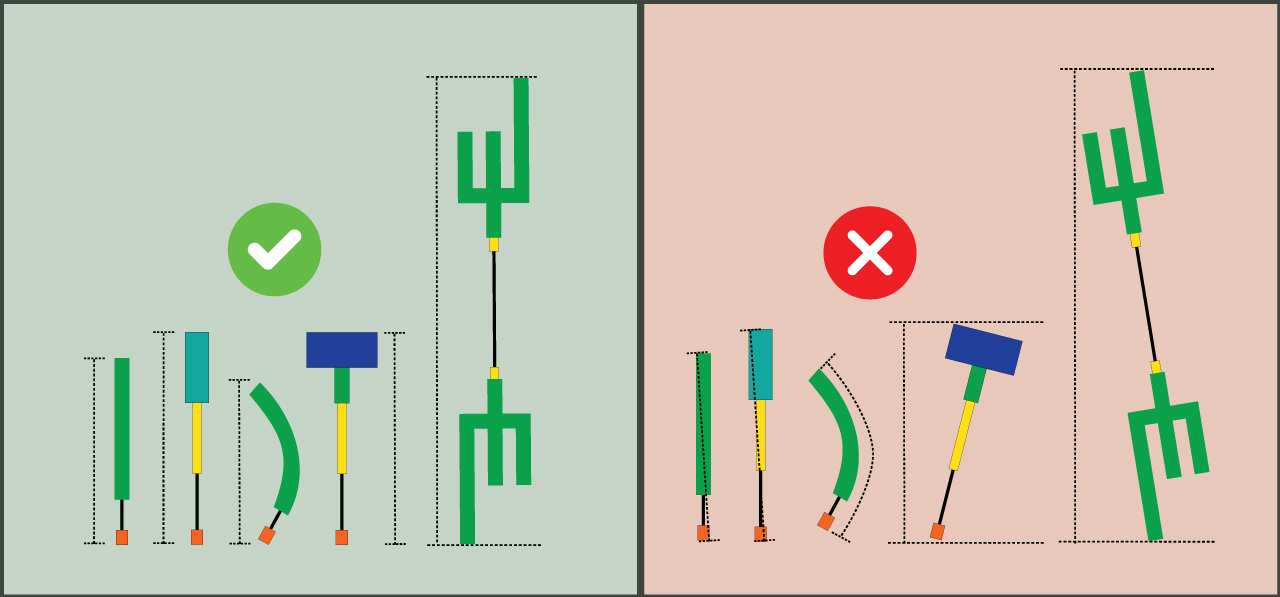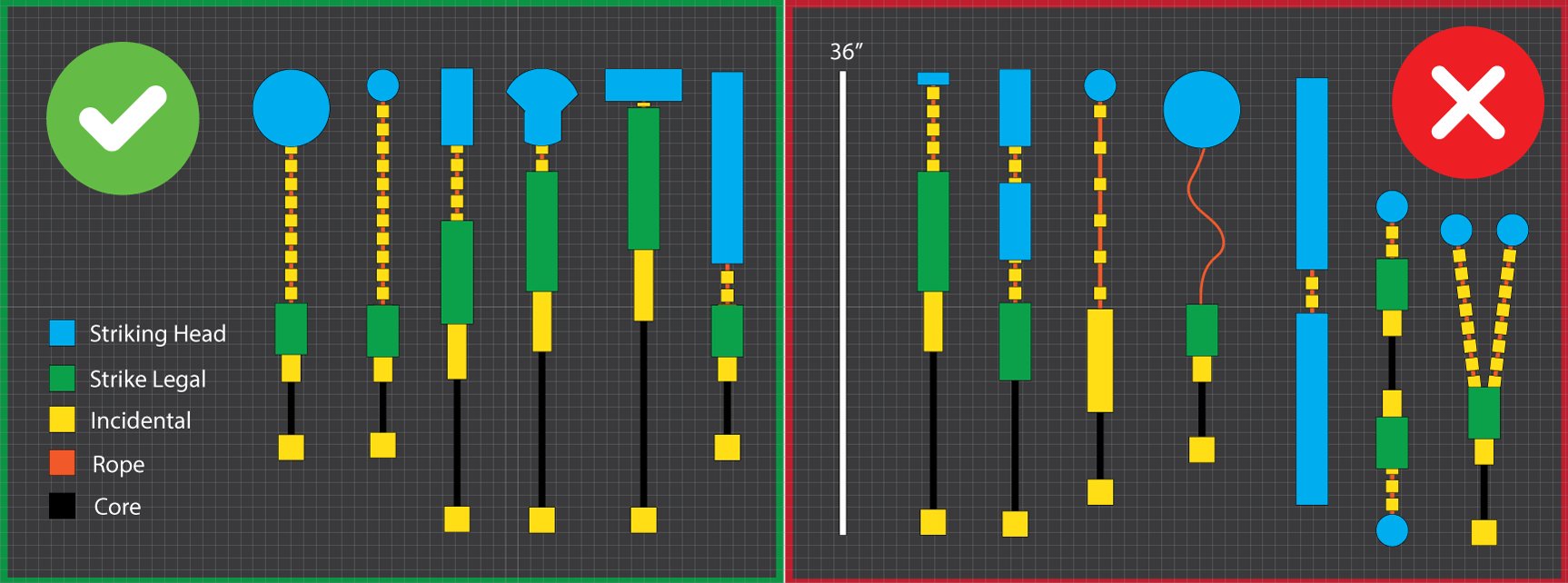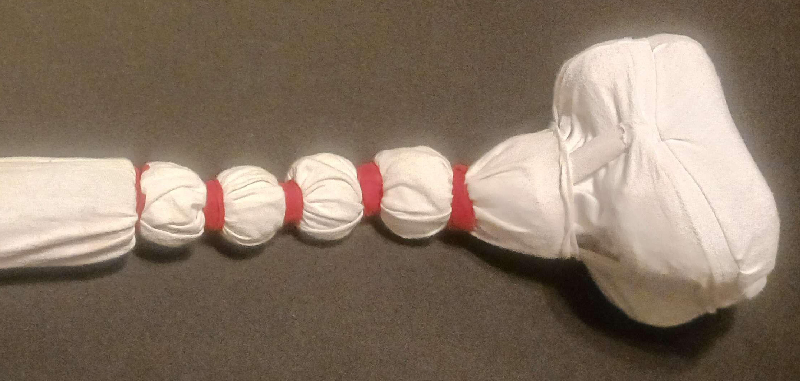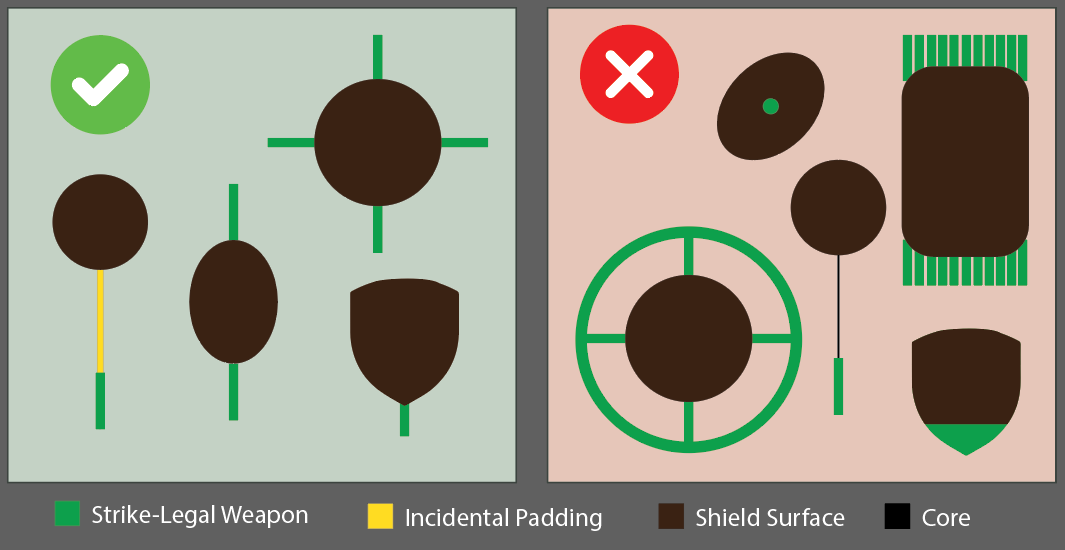V9: Weapons
- The Amtwiki is the official home and primary source for Amtgard V9 Rules as of February 25, 2023.
- These rules are currently in Open Alpha Playtest. See the Playtest Disclaimer for more details.
- To learn more about Amtgard V9 Development, please visit Amtgard.com.
- To view the current Amtgard V8 ruleset, please see the Amtgard V8 Rulebook.
Contents
- 1 Weapons
- 2 Glossary
- 2.1 Note About Unlisted Terms
- 2.2 Act
- 2.3 Affected
- 2.4 Amtgard Function
- 2.5 Amtgard International (AI)
- 2.6 Apprentice
- 2.7 Archery/Archer
- 2.8 Aggress
- 2.9 At-Arms
- 2.10 Authority
- 2.11 Boffer
- 2.12 Carried
- 2.13 Circle of Monarchs (AICOM/COM)
- 2.14 Class
- 2.15 Code of Conduct (COC)
- 2.16 Color Code
- 2.17 Comfort-Grade Foam
- 2.18 Contact Projectiles
- 2.19 Crossguard
- 2.20 Crushed
- 2.21 Curio
- 2.22 Damage
- 2.23 Death Count
- 2.24 Declarations
- 2.25 Destroyed / Destruction
- 2.26 Draw Length
- 2.27 Draw Weight
- 2.28 Dual Wield (Weapons)
- 2.29 Effect
- 2.30 🌶️Experimental
- 2.31 Flat Blade
- 2.32 Foam
- 2.33 Forced Movement
- 2.34 Free Hand
- 2.35 Game Item
- 2.36 Gameplay
- 2.37 Gameplay Advantage
- 2.38 Graze
- 2.39 Half-Draw
- 2.40 Harmless
- 2.41 Healed
- 2.42 Heavy Padding
- 2.43 Hit
- 2.44 Hit Locations
- 2.45 Hit Test
- 2.46 Hold (Safety Call)
- 2.47 Hold (in hand)
- 2.48 Illegal
- 2.49 Immediately
- 2.50 Invalid Obstructions
- 2.51 In-Character
- 2.52 In-Game
- 2.53 Knights
- 2.54 LARP
- 2.55 Legal
- 2.56 Line of Sight
- 2.57 Loaner Gear
- 2.58 Magic Switching
- 2.59 Move
- 2.60 Non-Player Character (NPC)
- 2.61 Non-Striking Surfaces
- 2.62 Nullified
- 2.63 Offensive (Ability)
- 2.64 Omni
- 2.65 Ongoing Effect
- 2.66 Open Hand
- 2.67 Out-of-Character
- 2.68 Out-Of-Game
- 2.69 Owner
- 2.70 Padding
- 2.71 Page
- 2.72 Paragon
- 2.73 Phys-Rep (Physical Representation)
- 2.74 Player Character (PC)
- 2.75 Player Versus Environment (PVE)
- 2.76 Player Versus Player (PVP)
- 2.77 Pommel
- 2.78 Prime
- 2.79 Reeve
- 2.80 Relic
- 2.81 Repair
- 2.82 Respawn
- 2.83 Restore
- 2.84 ROP (Rules of Play)
- 2.85 Rules Representative (RR)
- 2.86 Rules Representative Organizer (RRO)
- 2.87 Rules As Intended (RAI)
- 2.88 Rules As Spoken (RAS)
- 2.89 Rules As Written (RAW)
- 2.90 Safety-Grade Foam
- 2.91 Slash
- 2.92 Spirit of the Rules
- 2.93 Squire
- 2.94 Stabbing Projectiles
- 2.95 Streamers
- 2.96 Stab
- 2.97 States
- 2.98 Strike
- 2.99 Strike Legal
- 2.100 Striking Surfaces
- 2.101 Super Heavy Padding
- 2.102 Tails (Spellball Construction)
- 2.103 Talisman
- 2.104 Target
- 2.105 Terrain
- 2.106 Trinket
- 2.107 Unattended
- 2.108 Unwielded
- 2.109 Use
- 2.110 Version
- 2.111 Visible
- 2.112 Walking Pace
- 2.113 Wield
- 2.114 Worn
- 2.115 Wounds
- 2.116 Owner’s Name Label
- 2.117 Stab-Only
- 2.118 Strike-Legal Padding
- 2.119 Striking Tip
- 2.120 Total Length
- 2.121 Melee Weapons
- 2.122 Projectile Weapons
Weapons
Striking your opponent with a wielded weapon is the primary way to interact with them in combat.
General Rules
- Only weapons that meet the Universal Equipment Requirements can be used in combat.
- All Amtgard weapons are classified as either a ‘Melee Weapon’ or a ‘Projectile Weapon’, as well as a specific typing such as ‘Short’ or ‘Long’. Weapons of the same classification and typing have the same gameplay rules, regardless of their physical form.
For example, a ‘ Short’ melee weapon made to resemble an Axe will have the same gameplay rules as a ‘Short’ melee weapon made to resemble a Sword, Club, or even an atypical weapon like a Lute or Frozen Fish! - Unsupported Weapons: In-Game representations of explosives, firearms, and chemical weapons (such as Alchemist’s Fire or Toxic Gas) are not supported by the Amtgard Rules of Play. If something of this nature is desired for a special scenario, a Game Organizer is able to design and implement such rules on a game-by-game basis.
- Prohibited Weapons: For the safety and comfort of our players, Amtgard outright prohibits the following weapon styles and their variations. If you are unsure if a weapon design falls under these categories, consult a Reeve or other relevant Rules Authority.
- Entangling Weapons such as Whips, Lasso, Nets, and Bolas.
- Atlatls, Slings, Slingshots, and all other handheld projectile launchers that are not bows or crossbows.
- Punching weapons such as Knuckles, Punching Daggers, and Tonfas.
Construction Terms
Amtgard weapons are typically made from a structural core padded with foam and a cloth cover. Below is a diagram of of few typical weapons with their its component parts labelled. You can read the descriptionsfor each component below, which are listed in alphabetical order for ease of reference.
2.5 Inch and 2 Inch Rule
- No part of a weapon's striking surface, whether the tip, the edge, the face or any other part, may protrude more than 1.5" through a two-and-a-half inch (2.5") ring when uncompressed.
- No part of a weapon or shield's non-striking surface such as the ends of crossguards or pommels may protrude more than 1.5" through a two-inch (2") ring when uncompressed.
Core
This refers to the structural base of the weapon to which padding is affixed.
- Rigid Cores
Melee Weapons require a rigid core to provide structural stability. Short weapon segments and small protrusions from a central core that are stable on their own do not require a rigid core within them. These segments and protrusions must not deform or fold over excessively during combat and must always return to their original position.- The best materials to use are carbon/graphite rods (such as from non-metallic golf clubs), kite spar, bamboo, PVC tubing, or fiberglass. Other materials will be assessed for safety on a case-by-case basis.
- Metal and wooden cores are prohibited. Metal may be used to counter-weight weapons provided it is permanently attached and not in a place that may inadvertently strike another player.
- The ends of any rigid cores should have a flat face and be securely capped with a layer of foam and tape at minimum to prevent the core from pushing through.
- Hollow cores should be sealed at the ends.
- Sharp edges should be blunted so as to not dig into the padding.
- Non-Rigid Cores
Contact Projectiles require a non-rigid, non-granunlar core.- The best materials to use are foam (any), denim, sweatshirt material, loose rubber bands, etc.
- Unacceptable cores include: Solid rubber, tightly-wrapped rubber bands, tennis balls, beanbags, seed packets, etc.
Covers
All striking surfaces must be covered in a durable, opaque cloth and be visually distinct from any non-striking surfaces. Incidental padding within 0.5" of a striking surface must also be covered in this manner. Non-abrasive cloth tape (not duct tape) may be used for Contact Projectiles but it is not an acceptable cover material for melee weapons or arrows.
Flex
This refers to how much a melee weapon can bend safely during normal use. Flex is measured by holding the weapon low on the handle for maximum length and striking a shield or padded surface. A second person can then estimate the flex.
- The maximum allowed flex for any weapon is 45 degrees.
Padding and Foam
All Amtgard weapons and shields require some amount of padding to prevent player injuries. In this context, padding refers to either Strike-Legal Padding or Incidental Padding. The type required will determine which materials are acceptable to use for this purpose. If a piece of equipment simply requires "padding", "foam" or "cushioning" with no other description, then you can meet that padding requirement with either Strike-Legal or Incidental Padding.
Foam Grades
Foams can vary widely in terms of how they will act when used as padding so it is important to choose one that helps ensure your equipment will meet the universal equipment requirements - notably safety and durability. When in doubt, take the time to learn from an experienced player or study an online construction tutorial.
This rulebook may refer to two amtgard-defined categories of foam: Safety-grade and Comfort-grade.
Safety-Grade Foam
Safety-Grade Foams are sturdy and provide firm resistance to compression when tested with the pads of fingers, but are not rigid. The goal of Safety-Grade Foams is to provide the primary padding for weapons. Safety-Grade Foams should, when used in the specified thicknesses, prevent injuries and limit discomfort experienced by other players when they are struck with weapons during combat.
- Typical foams in this category include "blue camp pad", "pool noodle", and microcell foam.
Note: Safety-Grade foams sometimes come in multiple densities or stiffnesses and not all of them are safe for use on their own. Higher stiffness or density Safety-Grade Foams may not be suitable for use as the sole padding on a weapon but may improve the durability and striking comfort of a weapon when used as a base layer of foam closest to the core, with less stiff or dense Safety-Grade foam on top. Padding a weapon using multiple Safety-Grade Foams with different properties is referred to as building with "progressive resistance" or "progressive density".
Comfort-Grade Foam
Comfort-Grade Foams are squishy and less firm than Safety-Grade Foams while still being dense enough to provide some resistance to typical Amtgard weapon impacts. The goal of Comfort-Grade Foams is to provide greater shock absorption and further reduce discomfort from weapon impacts which may not be sufficiently mitigated by Safety-Grade Foams alone.
- Typical uses for Comfort-Grade Foams include additional padding on stabbing tips, arrows, and javelins.
- Comfort-Grade Foams should not be used on their own to pad a core.
- Typical foams in this category include "marine foam" and "high-density charcoal foam".
Extra Notes
- Very dense or rigid foam can be used as part of a structural core but it will not count towards any mandatory padding requirements. Polystyrene (hard TV packaging) is an example of a foam that is too rigid.
- Very soft and light foam can be used to add shape or extra comfort but will not count towards any mandatory padding requirements.
Padding and Foam
All Amtgard weapons and shields require some amount of padding to prevent player injuries. In this context, padding refers to either Strike-Legal Padding or Incidental Padding. The type required will determine which materials are acceptable to use for this purpose. If a piece of equipment simply requires "padding", "foam" or "cushioning" with no other description, then you can meet that padding requirement with either Strike-Legal or Incidental Padding.
Foam Grades
Foams can vary widely in terms of how they will act when used as padding so it is important to choose one that helps ensure your equipment will meet the universal equipment requirements - notably safety and durability. When in doubt, take the time to learn from an experienced player or study an online construction tutorial.
This rulebook may refer to two amtgard-defined categories of foam: Safety-grade and Comfort-grade.
Safety-Grade Foam
Safety-Grade Foams are sturdy and provide firm resistance to compression when tested with the pads of fingers, but are not rigid. The goal of Safety-Grade Foams is to provide the primary padding for weapons. Safety-Grade Foams should, when used in the specified thicknesses, prevent injuries and limit discomfort experienced by other players when they are struck with weapons during combat.
- Typical foams in this category include "blue camp pad", "pool noodle", and microcell foam.
Note: Safety-Grade foams sometimes come in multiple densities or stiffnesses and not all of them are safe for use on their own. Higher stiffness or density Safety-Grade Foams may not be suitable for use as the sole padding on a weapon but may improve the durability and striking comfort of a weapon when used as a base layer of foam closest to the core, with less stiff or dense Safety-Grade foam on top. Padding a weapon using multiple Safety-Grade Foams with different properties is referred to as building with "progressive resistance" or "progressive density".
Comfort-Grade Foam
Comfort-Grade Foams are squishy and less firm than Safety-Grade Foams while still being dense enough to provide some resistance to typical Amtgard weapon impacts. The goal of Comfort-Grade Foams is to provide greater shock absorption and further reduce discomfort from weapon impacts which may not be sufficiently mitigated by Safety-Grade Foams alone.
- Typical uses for Comfort-Grade Foams include additional padding on stabbing tips, arrows, and javelins.
- Comfort-Grade Foams should not be used on their own to pad a core.
- Typical foams in this category include "marine foam" and "high-density charcoal foam".
Extra Notes
- Very dense or rigid foam can be used as part of a structural core but it will not count towards any mandatory padding requirements. Polystyrene (hard TV packaging) is an example of a foam that is too rigid.
- Very soft and light foam can be used to add shape or extra comfort but will not count towards any mandatory padding requirements.
Multi-Ended Weapons
Any melee weapon may have multiple segments and striking tips.
- Each segment that is intended to slash and stab must be Strike-Legal for at least 1/3 of the weapon's total length or 18", whichever is less, starting from the striking tip and moving continuously inwards. If the segment merges before the required amount is reached, the merged section that continues toward the handle counts for this total.
- Madu segments intended to stab and slash only require Strike-Legal padding for 1/3 of the weapon's total length or 12", whichever is less.
- Segments intended to be Stab-Only only require 6" of Strike-Legal padding.
- Segments must not be arranged in such a way that could create a high risk of a non-striking surface contacting a player when the weapon is used to strike normally. Any non-striking segments that are out of the way but could still reasonably come into contact with another player, such as crossguards, must be covered with Incidental Padding.
- If a weapon has both regular and stab-only segments, they must not be arranged in such a way that could risk a player being struck with the side of a stab-only segment when the weapon is used to slash.
- Multi-ended weapons must meet all other requirements for its weapon type.
Glossary
Note About Unlisted Terms
If a term is not defined anywhere in this rulebook, the most commonly accepted definition of the term should be applied. If multiple definitions exist, use the one that makes the most sense. Anything with an existing definition elsewhere in this rulebook will have a link to the actual entry. Anything not listed elsewhere will be fully defined here.
Developer Note: This is a work in progress based on the terms and keywords that we believe players will want to reference. Feel free to suggest terms for inclusion on the Amtgard V9 Discord Server.
Act
Dictionary Definition: (verb) - take action; do something.
In Amtgard, the term 'act' refers specifically to in-game actions.
If a player is unable to act, they are unable to do anything in-game. This includes but is not limited to:
- Moving from their current location
- Physically moving their body in any way
- Speaking
- Casting
- Chanting
Players may always make declarations regardless of their ability to act. They may also move and speak freely for out-of-game purposes, such as for safety reasons. Actions taken this way should be done in good faith and not used to generate a gameplay advantage.
Affected
When used in the context of gameplay, Affecting something means successfully imparting an in-game mechanic onto something else, such as a Wound, a State, or even an instance of Shield Crush.
Blocking, parrying, evading, or otherwise being immune to an effect will not count as being affected, however triggering Resistances and other limited forms of protection do count as being affected because the interaction is still imparting some kind of change.
Provoking physical movement and/or mind games do not count for the purposes of 'Affect'. A player that is intimidated by their opponent does not count as being affected. A player that dodges or successfully runs away from an ability does not count as being affected.
Amtgard Function
A catch-all term for Amtgard gatherings, regardless of size or purpose.
Amtgard International (AI)
Amtgard International is the overall governing body of Amtgard. You can learn more about them on the official Amtgard website: https://www.amtgard.com
Apprentice
An Apprentice is a player who is under mentorship from a Paragon. Apprentices may wear a Silver-Trimmed Belt Favor in the color of the associated class.
Archery/Archer
Only people playing the Archer class are referred to as Archers in Amtgard. For the sake of ambiguity, a player using a bow in any context is referred to as a Bow-User.
Aggress
A player has aggressed against another player if they do one or more of the following:
- Target that player with an offensive verbal ability (regardless of completion).
- Strike that player or their carried equipment.
- This does not apply if that player intercepted an attack intended for someone else.
- This does not apply if that player intercepted an attack intended for someone else.
- Clearly commit to an attempt to strike that player, as judged in good faith by the player receiving the attack.
- This is intended to cover instances where a deliberate attack was made but missed; however it also extends to obvious feints that could have been real strike attempts.
At-Arms
An At-Arms is a player who is under mentorship from a Knight or Noble. Pages may wear a Black Belt with Silver Trim to signify their position.
At-Arms can also be referred to as: Man-At-Arms, Woman-At-Arms, Comrade-at-Arms, Sword-at-Arms, Shieldmaiden, Shield Brother, or other similar terms.
Authority
Authorities are players within the game that have the power or right to give orders, make decisions, and enforce obedience within a certain realm of the rules. The common Amtgard authorities include Rules and Safety Authorities and Officers.
Boffer
A boffer is a common term used to describe a foam-padded weapon used for full speed LARP combat. Latex-coated weapons are not considered Boffers.
Carried
See Carried.
Circle of Monarchs (AICOM/COM)
A council of leaders. In Amtgard, the Amtgard International Circle of Monarchs (AICOM) is composed of the Monarchs of each Kingdom. Within each Kingdom, a Circle of Monarchs includes the Monarchs of each park therein.
Class
See Classes
Code of Conduct (COC)
See Code of Conduct
Color Code
See Color Code
Comfort-Grade Foam
See Padding
Contact Projectiles
Crossguard
This refers to an optional portion of a Melee Weapon at the juncture of the blade and handle designed to deflect blows and protect the hand from injury. In Amtgard V9, crossguards follow the rules for Multi-Ended Weapons.
Crushed
A Shield or Madu which has been struck by a Shield Crushing effect but is not yet destroyed.
Curio
See Magic Items.
Damage
A strike or effect deals damage if:
- A wound is caused
- Armor points are removed
- The victim uses a resistance to prevent either of the above
If the victim is Immune to, or cannot be affected by the effect, such as via Insubstantial, damage is not dealt to that player.
Death Count
See Death Count
Declarations
Declarations are mandatory spoken statements used to inform other players about the state of the game. All forms of required communication other than casting should be treated as a declaration and follow the rules listed below.
- The goal of a declaration is to be prompt and ensure other players understand what is being declared.
- Declarations are not incantations. Unless specifically noted, precise wording is not required as long as the relevant players understand what is being conveyed. With that in mind, players should act in good faith when it comes to mispronunciations or potentially misleading declarations.
- Declarations do not interrupt chants, incantations, or other game mechanics that require speech; however all timing rules for those mechanics must still be adhered to.
- For example, you cannot have a gap of more than 2 seconds if you declare something in the middle of an incantation.
- Declarations do not count as speaking in-game and will not trigger roleplay effects that are sound activated.
- For example, a player declaring that they are Frozen should not wake the sleeping dragon.
- Players are always allowed to make declarations regardless of their in-game ability to speak. They may also make physical gestures to aid with this communication, regardless of their in-game ability to act. This should all be done in good faith. Players should not use these rules as a means to gain a gameplay advantage in a situation where they could not otherwise speak and/or move.
- For example, a Frozen player can make a shivering motion and shout ‘Frozen!’ despite not being allowed to speak or act in-game; however they cannot shout 'Frozen' in different tones as a way to warn their team about an impending flank attack.
- Declarations must be loud and clear enough to be heard and understood within 50ft or by the specific players that need to hear it, whichever is closer. If a declaration is just a general proclamation, such as declaring 'Alive!" when Respawning, it must be heard and understood clearly out to 20ft.
- Players may openly request other participants to declare certain types of information. That information should be provided as soon as is reasonable and both sides of this exchange must act in good faith and avoid exploiting the exchange for gameplay advantage.
- Players may request declarations for anything that is explicitly public information. This includes, but is not limited to, the following:
- Armor coverage and maximum armor point values for each location
- Wounds
- Enchantments on the player and/or a brief summary of their effects
- A brief summary or effect description for any visual indicators on a player.
- Status effects
- The effects of any Chants a player is maintaining.
- Strike Enhancements
- Destroyed equipment
- Immunities and Resistances
- Class and level
- Whether they are Alive or Dead
- "What does that do?" (Asking a caster or attacker for information about something they just did to you.)
- The following information is private information. It can be requested however players are only obligated to answer when asked by the Reeves and Rules Authorities for the activity in question::
- Armor points remaining on damaged hit locations
- How many shield-crushing strikes a shield has already received.
- Class customization choices and spell lists
- Ability maximums and how many uses are remaining.
- Time remaining on status effects
- Rest counts
- Death counts
- Players may request declarations for anything that is explicitly public information. This includes, but is not limited to, the following:
- When declaring variable effects that had a choice, the player must declare the chosen choice or a summary of its effects.
- For example, declaring your enchantment as simply “Adaptive Blessing” is not sufficient because it does not convey the choice. “Adaptive Blessing Stopped” or “Resistant to Stopped” would be sufficient.
- Due to the chaos of live combat, declarations can often be difficult to enact and even harder to regulate. Therefore, it is important for participants to set their expectations accordingly and do their best to help convey information as fairly and effectively as possible.
Destroyed / Destruction
See Destroyed
Draw Length
Draw length is the measurement from the deepest part of the bow grip to the nock groove when at full draw.
Draw Weight
“Draw weight” means the amount of force needed to pull a bowstring to full draw. This is commonly called the bow's poundage.
Calculating Draw Weight on a Vertical Bow
- Vertical bows measure draw weight in pounds.
- The simplest way to measure a bow’s draw weight is to use a scale that can hook onto the bowstring. Several bow draw weight scales are available that are designed for this purpose.
- Using a measuring device to draw the bowstring may make your draw shorter. Ensure you are bringing the bow to a 28” draw length.
- You can use a sufficiently long arrow and mark the 28” draw point on it so when taking measurements in the future, you can use this “ruler” arrow to save time.
Calculating Draw Weight on a Crossbow
- Crossbow draw weight is measured in Inch-pounds and requires a few extra steps compared to vertical bows.
- Inch-pounds are calculated by multiplying draw weight (see above) by the power stroke.
- Power stroke is the length between the crossbow's string in the rearmost (cocked) position and its resting (uncocked) position, measured in inches. It very roughly equates to draw length in a vertical bow.
450 Inch-Pound Quick-Reference Chart
Below is a mathless way to determine if your crossbow is legal for use in Amtgard combat. Consult the chart below and find your crossbow's power stroke. If your draw weight is equal or less than the associated value, it is legal. If it is greater, then the crossbow cannot be used.
| If Power Stroke is... | Then Your Max Draw Weight is... |
|---|---|
| 6 | 75.0 |
| 6.5 | 69.2 |
| 7 | 64.3 |
| 7.5 | 60.0 |
| 8 | 56.3 |
| 8.5 | 52.9 |
| 9 | 50.0 |
| 9.5 | 47.4 |
| 10 | 45.0 |
| 10.5 | 42.9 |
| 11 | 40.9 |
| 11.5 | 39.1 |
| 12 | 37.5 |
| 12.5 | 36.0 |
| 13 | 34.6 |
| 13.5 | 33.3 |
| 14 | 32.1 |
| 14.5 | 31.0 |
| 15 | 30 |
| 15.5 | 29 |
| 16 | 28.1 |
| 16.5 | 27.3 |
| 17 | 26.5 |
| 17.5 | 25.7 |
| 18 | 25.0 |
| 18.5 | 24.3 |
| 19 | 23.7 |
| 19.5 | 23.1 |
| 20 | 22.5 |
Dual Wield (Weapons)
A player is dual wielding weapons if they are wielding two melee weapons, one in each hand.
Effect
See Effect
🌶️Experimental
Playtest rules listed as with a 🌶️ are 'Experimental' and represent more extreme or 'spicy' concepts that we feel can be better judged through actual playtesting. Due to this unknown, these rules will be under close examination and are are more likely than other playtest rules to be changed quickly or removed entirely if feedback and playtest results are unsatisfactory.
Flat Blade
A Flat Blade is a common term used to describe a weapon that is made with only one or two striking edges instead of being Strike-Legal throughout its entire circumference.
Foam
See Padding
Forced Movement
Forced Movement occurs whenever a player is required to move by some sort of in-game effect. Abilities such as Shove and Teleport are examples of Forced Movement.
Free Hand
See Held
Game Item
This term usually refers to a portable game objective or another object that is important to the current activity. Some abilities may behave differently, or not at all, while a Game Item is being carried.
Gameplay
Gameplay refers to any in-game action or effect that occurs in an activity or as part some other Amtgard experience.
- Running, jumping, attacking, casting, talking to team-mates, etc. are all examples of gameplay.
- Strikes, abilities, terrain effects, boundaries, and all custom rules are also part of gameplay.
- Answering your phone, hydrating, talking to out-of-game spectators, etc. are not considered part of gameplay.
Gameplay Advantage
A player gains a Gameplay Advantage whenever they improve their situation or otherwise put themselves into a favorable or superior position compared to their opponents.
If a player is instructed to avoid gaining a gameplay advantage due to X, it means that the player should not capitalize any opportunities presented by X. This typically relates to the Honor System and often deals with the expected etiquette of LARP interactions.
Graze
A common term for an invalid strike. Often used to refer to one of the following:
- Brief contact that is neither percussive nor stops or noticeably deflects.
- A melee or projectile stab which fails to strike with the tip but instead brushes against a victim with the side and barely deflects, if at all, instead of impacting cleanly.
Half-Draw
Amtgard defines 'Half-draw' as when the bowstring is at the midway point between its natural resting point and full draw.
Harmless
See Nullfied.
Healed
The term 'Healed' is a commonly used term to refer to the removal of wounds. It does not mandate the use of the Heal spell.
Heavy Padding
See Strike-Legal
Hit
Another term for 'Strike'.
Hit Locations
See Hit Locations
Hit Test
A Hit Test is part of the Equipment Inspection requirements. It involves a player being physically hit with a weapon in a controlled environment to determine if it is safe and comfortable enough to be allowed on the battlefield.
Hold (Safety Call)
See Hold
Hold (in hand)
See Held
Illegal
The term 'Illegal' is used within Amtgard to describe something that is not in line with the rules of the game. Usually this refers to a piece of equipment but it can also refer to maneuvers or behaviors.
Immediately
When an ability or mechanic uses the term ‘immediately’ it means as soon as reasonably possible, handled fairly and in good faith.
- For beneficial effects, such as resistances, the player must use or declare the effect within a reasonable window of ‘immediately’ or forfeit the benefit.
- For harmful effects, if the victim cannot realistically apply the effect immediately due to physical momentum or personal processing times, they must do their best to not derive any gameplay advantage from the delayed effect.
Invalid Obstructions
In-Character
If you're roleplaying, you're in-character.
When you're in-character, everything you say and do is said and done as your character, to be interpreted by other characters within the roleplay experience.
When you are no longer roleplaying this way, you are out-of-character.
In-Game
Pertaining to game information and game mechanics. Team communication, strategy, damage, abilities, etc.
Knights
See Knighthood
LARP
See New To Larp And Boffer Combat?
Legal
The term 'Legal' is used within Amtgard to describe something that is in line with the rules of the game. Usually this refers to a piece of equipment but it can also refer to maneuvers or behaviors.
Line of Sight
See Line of Sight
Loaner Gear
This term is used to refer to pieces of equipment or garb that are intended to be lent out to players for the day. There is no guarantee that loaner gear will be available at any given event or function so it is best to inquire with your local park to determine what is available.
Magic Switching
Magic Switching is a term used across many Boffer LARPs to describe a player passing their weapon or equipment from one hand to another upon being wounded instead of dropping the equipment to the ground first.
Magic Switching is allowed in Amtgard. You will never be required to drop your equipment during Amtgard combat.
Move
When used without any additional context, the term 'Move' in Amtgard refers to directional movement across an area, such as by walking, running, crawling, etc. For example, if a player is not allowed to move, they can still shift their physical limbs and fight, they just cannot change their physical position on the battlefield.
If an effect intends to restrict a different type of movement, it will call it out directly such as "Player may not move their arms." In these instances, the player is prevented from physically moving the specified parts.
Remember, players are always allowed to move and speak if necessary to ensure their own safety, regardless of any effects that would otherwise restrict them from doing so.
Non-Player Character (NPC)
This term is used to refer to participants in an activity that is experiencing it from role of the 'supporting cast', such as quest-givers and monstrous creatures. This term is most often used in Roleplay activities alongside its opposite term, "Player Character (PC)", which represents the participants who are the actual 'players' or 'main characters'.
For a video game analogy, PCs are characters controlled by humans and NPCs are characters controlled by the game. Since Amtgard is live action, both PCs and NPCs need to be portrayed by actual people and the distinction purely exists to highlight who the experience is focusing on.
PCs are almost always portrayed as a character chosen by that player. NPCs are typically special characters designed and scripted specifically for the activity.
Non-Striking Surfaces
A non-striking surface is a surface on a weapon that cannot be used to strike with. Non-Striking Surfaces must be visually distinct from Striking Surfaces.
Non-striking surfaces include: Incidental Padding, Non-Striking Tips, and Handles.
Nullified
Something that is nullified or renders harmless is considered to have no further effect on gameplay. It cannot cause damage nor impart any other kind of effect. Attacks that are nullified are only nullified for that instance of the attack, additional attacks from the same source are not nullified forever. For example, if a Monk nullifies an arrow, that arrow can still be retrieved and used again as normal.
Offensive (Ability)
Omni
'Omni' is a common term used to describe a weapon that has Strike-Legal padding on all sides of the core. It has omnidirectional padding.
Ongoing Effect
Open Hand
Open Hand is used as a synonym for Free Hand.
Out-of-Character
When you are not roleplaying, you are out-of-character. Everything you say and do is from the perspective of the real, mundane world, not as actions within a roleplay scenario. You are being yourself, not embodying a fictional character.
When you are start roleplaying, you become in-character.
Out-Of-Game
Pertaining to things unrelated to the game or activity. “Do you want to get food later”, “I hurt my arm”, etc..
Also includes support staff, Reeves, and spectators that are present but not actively participating.
Owner
For the vast majority of game mechanics, the owner of a physical item is the person who has ownership of it in real life, outside of Amtgard. Any rules that are refer to in-character ownership will be obvious or explicitly worded as such.
All Projectile Weapons must have their owner's name clearly labelled on the item.
Padding
See Padding
Page
A Page is a player who is under mentorship from a Knight or Noble. Pages may wear a Yellow Belt to signify their position.
Paragon
See Paragon
Phys-Rep (Physical Representation)
This term is used to describe the real world item being used to represent something in-character, such as a small bottle of glitter being used to represent a Potion of Healing.
The term "Phys-Rep" most commonly applies to Magic Items.
Player Character (PC)
This term is used to refer to any participant in an activity that is experiencing it in the role of a 'player' or 'main character'. This term is most often used in Roleplay activities alongside its opposite term, "Non-Player Character (NPC)", which represents participants who are playing the 'supporting cast', such as quest-givers and monstrous creatures.
For a video game analogy, PCs are characters controlled by humans and NPCs are characters controlled by the game. Since Amtgard is live action, both PCs and NPCs need to be portrayed by actual people and the distinction purely exists to highlight who the experience is focusing on.
PCs are almost always portrayed as a character chosen by that player. NPCs are typically special characters designed and scripted specifically for the activity.
Player Versus Environment (PVE)
A PVE activity is an activity where the players (aka PCs) are all on the same team or otherwise not expected to fight each other to achieve victory. Instead, they are pitted against Non-Player Characters (NPCs) who are scripted supporting characters and monsters. These NPCs are typically not looking to win, rather their goal is to provide an immersive and exciting challenge for the PCs to overcome as they adventure through whatever story that is being presented. The alternative to PVE is Player Versus Player (PVP).
Player Versus Player (PVP)
A PVP activity is an activity where there are multiple teams of players (aka PCs) who are required or otherwise encouraged to fight each other to achieve victory. The alternative to PVP is Player Versus Environment (PVE).
Pommel
The Non-Striking Tip just below the handle of a melee weapon is called the pommel.
Prime
Certain strike-based abilities need to be cast before the actual attack can be made. This is called "priming".
See Spellballs and Power Strikes for more details.
Reeve
See Reeve
Relic
See Magic Items.
Repair
Repair is a term commonly used to refer to the restoration of equipment such as weapons and armor, usually via the Mend spell or some similar effect.
Respawn
A multi-purpose word that deals with players returning to life using the Respawn mechanics.
- When used as a verb, it refers to the act of Respawning.
- "Hey guys, our Death Count is finished, let's go Respawn!"
- "Hey guys, our Death Count is finished, let's go Respawn!"
- When used as a noun, it is often shorthand for 'Respawn Point'.
- "Does anyone know where the Respawn is for this game?"
Restore
'Restore' is a general term used to refer to when something is returned or otherwise brought closer to its original state.
- Restoring Wounds means that the wounds are removed.
- A destroyed weapon that is restored is no longer destroyed.
- An effect that restores 2 points of armor will increase a player's current armor point value by 2, up to their maximum value.
- An effect that restores 1 use of an ability will grant another use of that ability, up to the maximum available.
- And so on.
ROP (Rules of Play)
The term 'ROP' refers to the Amtgard Rules of Play.
For Amtgard V9, it is this document.
For other editions of Amtgard, visit Amtgard.com or search elsewhere on the wiki.
Rules Representative (RR)
Rules Representatives are appointed members from each Kingdom that act as ambassadors for their populace in official rules-change discussions.
Rules Representative Organizer (RRO)
The RRO is the person in charge of coordinating and overseeing the Rules Representatives, ensuring they are contributing to the various official rules-change discussions and safeguarding the integrity of the process.
Rules As Intended (RAI)
This term is a lesser-used synonym for Spirit of the Rules.
Rules As Spoken (RAS)
This refers to a way in which the rules text may be interpreted. In this case, RAS means considering how one player might verbally explain a rule to another player from memory without the use of the rulebook.
If a player learns something via Rules As Spoken then they may not have received all the nuance and little details that are essential for true understanding.
Rules As Written (RAW)
This refers to a way in which the rules text may be interpreted. In this case, RAW means interpreting the rules exactly how they are written in the document, including any technicalities and counter-intuitive exploits that may allow. There is no consideration made for thematics or the intentions of the author.
Safety-Grade Foam
See Padding
Slash
A strike with the edge of a weapon.
Spirit of the Rules
Considering the "Spirit of the Rules" is to consider the real meaning or intention of a rule, even if the way it is written does not properly express it.
While the goal is to present all rules in such a way that their written form conveys their intended form, sometimes differing player interpretations can cause confusion. This is most often true when you begin to consider the very many ways that rules can interact with one another.
While it is usually fairly simple to speculate about what the Spirit of a Rule is, the only way to know for sure is to ask the developers.
Squire
A Squire is a player who is under mentorship from a Knight. Squires may wear a Red Belt to signify their position.
Stabbing Projectiles
Streamers
The term is almost exclusively used to refer to an extra bit of loose material sticking out from the back of a Spellball to help make it visually distinct from a Small Thrown. Streamers are also referred to as 'tails'.
Stab
A thrusting strike with the tip of a weapon.
States
See States
Strike
The common term used in this book to describe hitting another player with a weapon. See Striking Your Opponent.
Strike Legal
See Strike-Legal
Striking Surfaces
This refers to the surface portion of any Strike-Legal weapon; the physical surface that will impact a player.
Super Heavy Padding
See Strike-Legal
Tails (Spellball Construction)
See 'Streamers'.
Talisman
See Magic Items.
Target
See Casting
Terrain
In Amtgard, ‘Terrain’ refers to the physical features of a tract of land or structure, whether real or imaginary.
Imaginary terrain features, such as lava pits or the walls of a magical maze, are outlined or physically denoted in some way by the Game Organizer. Their specific rules and what they obstruct will be made known by the organizer before the activity starts.
Real terrain is actual physical terrain. It will naturally obstruct movement, attacks, and/or line of sight by actually preventing those things from occurring in real life. Game Organizers may place further rules on real terrain, such as preventing players from moving or attacking through dense foliage or rivers, even if it would be physically possible for someone to do it.
Trinket
See Magic Items.
Unattended
See Unattended
Unwielded
Use
The dictionary defines 'Use' as: `To employ something as a means of accomplishing a purpose or achieving a result.`
This is a common sense term. When equipment is involved, it usually means wielding or wearing it, as appropriate. When abilities are involved, it usually means casting or otherwise expending the effect.
If this term is presented ambiguously anywhere in this rulebook, please reach out to the Amtgard V9 Team or your local Rules Representative so we can correct it.
Version
Amtgard uses the term 'version' to refer to it's major rules editions. Version 9 will be the 9th Edition of the Amtgard Rules of Play.
Visible
If an object must be visible, it must be able to be easily seen and identified by other players and unlikely to become confused as, or obscured by, other garb or equipment (such as shields) for significant periods of time during the course of gameplay. It does not necessarily need to be in line of sight at all times.
Visibility should be handled in good faith by both the bearer and observers.
Examples of things that ARE considered visible:
- A Curio that is being worn as an amulet, hanging on top of the player's shirt.
- A CTF flag held in a sword hand and allowed to dangle.
Examples of things that are NOT considered visible:
- A Curio stored in a pouch.
- A CTF flag being held on the inside of a shield.
Walking Pace
The speed at which a person usually walks.
In Amtgard, this term is usually presented as `Slow Walking Pace`, which means a pace that a reasonable observer would define as 'slower than usual'.
Developer Note: ''Trying to exactly define a particular method or velocity for what constitutes a 'walking pace' is not realistic nor does it take into account the diverse ways that we may physically move around the battlefield, let alone the biological differences between players that affect what is 'normal'.As such, when interacting with rules that call for a 'walking pace', it is integral that players use common sense and act in good faith. We can all imagine what slow walking looks like. Don't try to exploit it. If you're ever in doubt, walk slower.
We appreciate your cooperation.''
Wield
See Wielded
Worn
See Worn
Wounds
See Wounds
((:V9: Ownership Label}}
Owner’s Name Label
All projectiles must be clearly labeled with their owner’s name. It does not need to be large or visible in combat, but it should be discoverable for reference when necessary.
- Projectiles without name labels should not be allowed on the field.
- Weapons designed explicitly to be shared, such as park loaner equipment, should be labeled with the park’s name.
Stab-Only
Any segment of a weapon may be built to be Stab-Only.
- As the name implies, weapon segments built to be Stab-only can only be used to stab.
- A Stab-Only segment requires 6" of Strike-Legal Padding. This padding must begin at the Striking Tip and extend down the length of the weapon on all sides of the core (A stab-only segment must be Omni.)
- This padding cannot be reduced by Heavy Padding or Super Heavy Padding.
- A weapon that is composed entirely of Stab-Only segments can replace all other Strike-Legal Padding required by its type with Incidental Padding.
- A weapon with both regular and stab-only segments must still meet the full padding requirements for its type.
- If a weapon has both regular and stab-only segments, they must not be arranged in such a way that could risk a player being struck with the side of a stab-only segment when the weapon is used to slash.
Strike-Legal Padding
Strike-Legal Padding is padding that is used to create striking surfaces that are safe to strike another player with.
- Weapons that require Strike-Legal Padding must be sufficiently padded to prevent injury if used to strike an opponent with the most force that could reasonably be expected in Amtgard combat. Combat contact with the strike-legal portions of a weapon must not be unreasonably painful, nor should it leave bruises or have the potential to break bones and teeth when used by an average player as well as its intended user.
- Regardless of the requirements listed below, Hit Testing will always be required to assess the more subjective aspects of Strike-Legal padding, such as impact force and player comfort.
- Since combat is chaotic and every participant has different pain tolerances and sensitive areas, occasional instances of uncomfortable contact should be expected, however repeated or egregious offenses from the same weapon should result in the weapon and/or the user being removed from play.
- No part of the weapon’s striking surface, whether the tip, the edge, the face or any other part, may protrude more than 1.5" through a two-and-a-half inch (2.5") ring when uncompressed.
- All Strike-Legal surfaces must have an opaque cover and be visually distinct from Non-Striking Surfaces on the same weapon.
Melee Strike Legal
In addition to the above, Strike-Legal padding on melee weapons must follow these additional rules:
- Strike-Legal Padding must begin at each Striking Tip and move inward along the core toward the handle. It must be continuous for the entire required length. Any forked segments that split from a Strike-Legal point must also be entirely Strike-Legal.
- Must have at least 1" of safety-grade foam over the weapon core.
- Must have a continuous cross-section of at least 2.5" from edge to edge.
- The entire circumference of the core does not need to be strike-legal, however any part of this circumference that is not strike-legal must be covered with Incidental Padding and cannot be used to strike.
- Striking Tips must be sufficiently capped to resist stab impact and prevent the core from pushing through. The foam should not deflect or fold over excessively when stabbing and always return to its original position.
- It is strongly recommended that weapons intended to regularly strike with a thrusting motion also include comfort-grade foam on the tip to further cushion the blow. Weapons designed for two-handed stabs, such as large pikes, may need even more padding than smaller, single-handed weapons. Hit Testing will help determine what is the ideal amount of extra padding for player safety and comfort.
Heavy Padding
A segment of a melee weapon is considered to have Heavy Padding if it meets the requirements for Strike-Legal padding and also has an edge-to-edge, cross-section of 4" or greater (instead of 2.5"). This extra padding must begin within 3" of the Striking Tip and proceed continuously towards the handle.
- Heavy Padding can apply to flat-blade weapons. The 4" cross-section does not need to be around the entire core.
Heavy Padding Substitution
For each inch of Heavy Padding added along the core, you may replace one (1) inch of required Strike-Legal Padding with Incidental Padding.
- Incidental Padding added in this manner must begin by replacing the padding closest to the handle and then proceed continuously towards the Striking Tip.
- A weapon cannot substitute more than 50% of its required Strike-Legal padding this way.
Super Heavy Padding
Super Heavy Padding follows the same rules as Heavy Padding except it requires a cross-section of 8" or greater. If both Heavy and Super Heavy padding are used together, the Super Heavy Padding must be closest to the tip.
Super Heavy Padding Substitution
This follows the same rules as Heavy Padding Substitution except for each inch of Super Heavy Padding added along the core, you may replace two (2) inches of required Strike-Legal Padding with Incidental Padding.
Striking Tip
The tip of any weapon segment that will be used to strike other players. All Striking Tips must have Strike-Legal padding.
- Must not protrude more than 1.5" through a two-and-a-half inch (2.5") ring when uncompressed.
- Must not end in an angle less than 90 degrees.
Total Length
The measurement used to determine weapon type.
- Straight weapons are measured in a straight line parallel to the core, from the furthest edge on one end to the furthest edge on the other end.
- All other weapons are measured by the largest straight distance between any two ends or edges.
Wunjo is working on organizing everything here. It's a mess. I know. I'm focusing on this stuff ABOVE this point right now.
Melee Weapons
General Rules
Melee weapons represent swords, axes, spears, flails, pole-arms and anything else that can be used to directly slash or stab an opponent in close combat.
- All melee weapons require a rigid core.
- Approved melee weapons may be used to strike with their Strike-Legal surfaces and block or parry with any portion of the weapon.
- Melee weapons can never be launched or thrown as a form of attack. Javelins are the only exception to this rule due to their ability to act as both as melee weapon and a projectile.
Dagger
- Must meet the Universal Equipment Requirements.
- Total length must be at least 12" (1ft), up to 24" (2ft).
- At least 2/3 of the weapon must be Strike-Legal.
Short
- Must meet the Universal Equipment Requirements.
- Total length must be greater than 24" (2ft), up to 36" (3ft).
- At least 2/3 of the weapon must be Strike-Legal.
Long
- Must meet the Universal Equipment Requirements.
- Total length must be greater than 36" (3ft), up to 48" (4ft).
- At least 2/3 of the weapon must be Strike-Legal.
Two-Hand Armor-Breaking Variant
- Any weapon segment that has at least 6" of Super Heavy Padding gains Armor Breaking when the weapon is wielded with two hands.
Great
- Must meet the Universal Equipment Requirements.
- Total length must be greater than 48" (4ft), up to 72" (6ft).
- Must be 50% padded and have at least 18" Strike-Legal.
Two-Hand Shield-Crushing Armor-Breaking (SCAB) Variant
- Any weapon segment that is Strike-Legal for at least 2/3 of the weapon's full length; or has at least 18" of Heavy Padding gains Armor Breaking and Shield Crushing when the weapon is wielded with two hands.
- Stab-Only segments require just 6" of Heavy Padding to gain this benefit. (Reminder: You cannot Shield Crush with a stab.)
Reach
- Must meet the Universal Equipment Requirements.
- Total length must be greater than 72" (6ft), up to 108" (9ft).
- Must be 50% padded and have at least 18" Strike-Legal.
Two-Hand Armor-Breaking Variant
- Any weapon segment that has at least 18" of Heavy Padding gains Armor Breaking when the weapon is wielded with two hands.
- Stab-Only segments require just 6" of Heavy Padding to gain this benefit.
Pike
- Must meet the Universal Equipment Requirements.
- Pikes are Stab-Only. They cannot be used to slash.
- Total length must be greater than 108" (9ft), up to 144" (12ft).
- Must be 50% padded and have at least 6" Strike-Legal as per Stab-Only.
Two-Hand Armor-Breaking Variant
- Any weapon segment that has at least 6" of Heavy Padding gains Armor Breaking when the weapon is wielded with two hands.
Flail
- Must meet the Universal Equipment Requirements.
- Is composed of a handle with a single chain and articulating head. It cannot be multi-ended.
- The total length of all three components cannot exceed 36" when gently pulled taut.
Flail Head
- Must be equal or larger than a 2.5" sphere.
- Must be entirely Strike-Legal.
- Cannot contain a rigid core.
- The combined chain-and-head portion may not exceed 18" in length when gently pulled taut.
- Must be constructed using soft, durable, non-abrasive materials, such as a cotton rope. Actual chains are prohibited. A rope-like core is not required as long as this section behaves like a chain and is not at risk of tearing apart under the stress of the flailing motion.
- If the chain portion is longer than 0.5", it must include small foam rings (or equivalent design) spaced no further than 0.5" apart along the entire length.
Flail Handle
- Must be at least 12".
- 50% of the flail handle must be padded.
- The top 1/3 closest to the chain must also be Strike-Legal.
- This padding must begin at point where the chain connects to the handle and extend down the length of the weapon on all sides of the core (i.e. it must be Omni).
- The amount of Strike Legal required cannot be reduced by Heavy Padding or Super Heavy Padding.
Flail Combat Rules
Only the head of a flail can inflict valid strikes, even though the handle segment also has strike-legal padding. This extra padding is intended to allow a player to strike the handle safely against other equipment so the flail can wrap around without damaging the struck equipment.
Madu
- Must meet the Universal Equipment Requirements.
- Total length must be between 18" up to 108" (9ft).
- Is a hybrid Melee Weapon and Shield.
- Any shield with weapons permanently affixed to it will be considered a Madu and must conform to these rules.
- Any weapon segments must be easily recognizable as weapons, and the shield portion must be easily recognizable as a shield.
- The division between weapon and shield segments must be visually distinct.
Madu Shield Portion
The shield portion must be a legal shield.
Madu Weapon Segments
Madu weapon segments are measured from the point where they extend beyond the shield.
- Must not extend outward from the face of the shield.
- Must not articulate or have a chain like a Flail.
- Must not mimic or offer similar protective coverage to that of a shield. If this is a case, the offending segments will count as part of the shield, not a weapon, and be forced to adhere to shield construction rules.
- Segments intended to be Stab-Only must be at least 6" long.
- Segments intended to both slash and stab must be at least 12" long.
- Segments that measure 18" or less must be entirely Strike-Legal.
- Segments that measure greater than 18" must have at least 18" of Strike-Legal Padding and have Incidental Padding for the remainder.
- Padding Substitution can only be used on segments greater than 18" and cannot reduce the amount of Strike-Legal to less than 18".
Two-Hand 'Great' Madu Variant
If the total length of the Madu is 72" (6ft) or less, the following variation can be used:
- Any weapon segment that is greater than 48" (4ft) and is at least 2/3 Strike-Legal or has at least 18" of Heavy Padding gains Armor Breaking and Shield Crushing when the weapon is wielded with two hands.
- Stab-Only segments require just 6" of Heavy Padding to gain this benefit.
Two-Hand 'Reach' Madu Variant
- Any weapon segment that is greater than 72" (6ft) and has at least 18" of Heavy Padding gains Armor Breaking when the weapon is wielded with two hands.
- Stab-Only segments require just 6" of Heavy Padding to gain this benefit.
Madu-Specific Combat Rules
- Madus do not have access to the variant options or gameplay rules of other weapon or shield categories, even if parts of the Madu are constructed to mimic those weapons or shields.
- Example 1: A Madu constructed with a small-size shield will still take up a free hand and cannot be strapped to the arm without a handle.
- Example 2: A super-heavy padded Madu that is between 36" and 48" will not gain Armor Breaking when wielded 2-handed because that variant is only available to Long weapons.
- A Madu can only be wielded if the player can wield both a non-staff weapon of the Madu’s total length (weapon portions + shield portions) and a shield equal to or greater than the Madu’s shield's size.
- The weapon segments can be struck and affected by weapon-specific effects such as Weapon Destroying, and the Shield portion can be struck and affected by shield-specific effects such as Shield Crushing and Shield Destroying. Once affected this way, the entire Madu is affected, for better or worse. If the weapon or shield portion is destroyed, the entire Madu is destroyed. If one part of the Madu is restored, the entire Madu is restored.
Javelin
- Is a hybrid Stab-Only Melee Weapon and Stabbing Projectile.
- Must meet the Universal Equipment Requirements.
- Total length must be between 36" (3ft), up to 72" (6ft).
- Must have a straight core with at most one Striking Tip per end.
- Each striking tip must have at least 6" Strike-Legal as per Stab-Only.
- All other Non-Striking Surfaces must be covered with Incidental Padding.
- Must have an ownership label as per projectiles.
Javelin Hybrid Combat Rules
- By default, a Javelin is a Stab-Only Melee Weapon. It cannot be used to slash.
- When thrown, it becomes a Stabbing Projectile and does not count as a melee weapon again until it becomes Unattended or Carried.
- Javelins become Armor Breaking and Shield Crushing once they have travelled their length through the air.
- Destroyed Javelins cannot be thrown.
Magic Staff
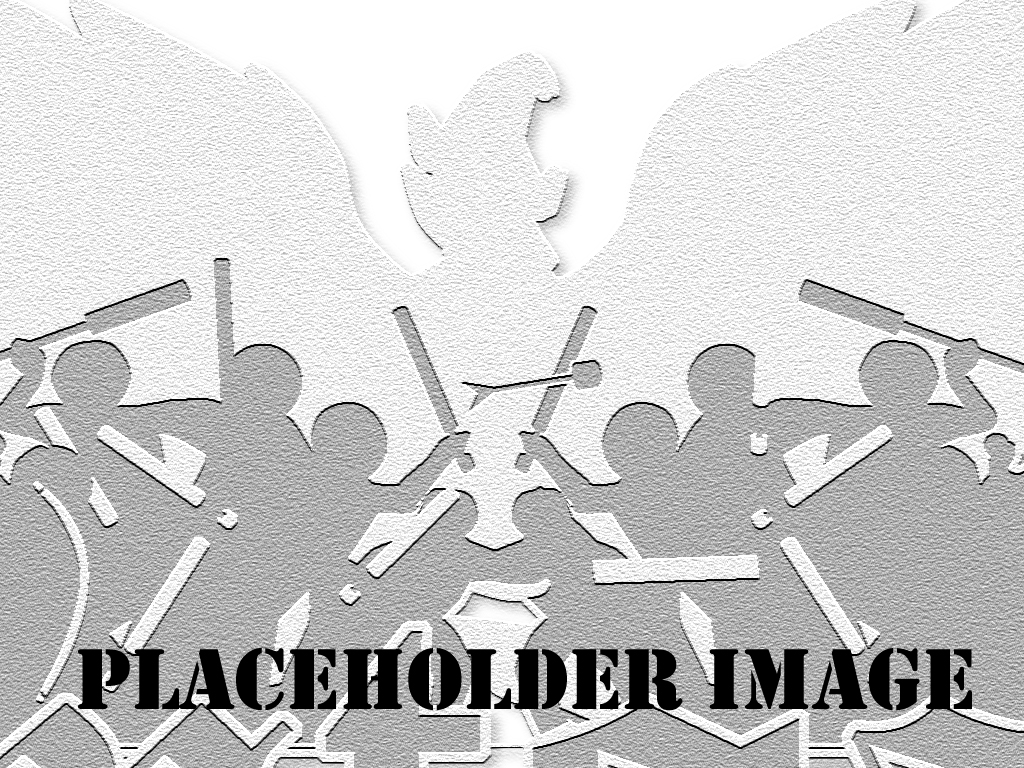
- Is a non-striking Melee Weapon (see combat rules below).
- Must meet the Universal Equipment Requirements.
- Total length must be at least 48" (4ft), up to 72" (6ft).
- Must have a straight core with exactly two non-striking ends.
- All core must be covered with Incidental Padding.
Magic Staff Combat Rules
- Cannot be used to strike. It can only block.
- Is a weapon. Can be destroyed like any other weapon.
- Does not take up a Free Hand when casting abilities.
- Players can only wield a single magic staff at a time.
Projectile Weapons
General Rules
Projectile Weapons represent anything that is launched or thrown to inflict damage or effects, such as arrows, kunai, chakrams, and tomahawks as well as magical blasts like fireballs and lightning. The following general rules apply to all forms of projectile weapons:
- May not be used to strike in melee.
- May not be used to parry or block.
- Cannot become destroyed by any means.
- May be carried in any number unless otherwise restricted, such as by class customization.
- All projectiles except Arrows and Bolts must be thrown by hand, one at a time, per hand.
- A player may hold a throwing weapon in each hand and throw both of them simultaneously, but cannot throw them together from the same hand.
- Arrows and Bolts must be fired from a bow or crossbow as appropriate.
- Each projectile can affect multiple targets in a single flight as long as each contact meets the criteria for a valid strike. Projectiles become harmless after their movement is completely halted.
- Batting, kicking, or otherwise applying significant force to a projectile in motion is prohibited.
- Arrows in flight must be blocked passively by placing an object in their flight path.
- Other non-arrow projectiles may be blocked, parried, or lightly struck out of the air.
- Players may not catch or grab projectile weapons in flight.
- Projectiles may be shared among players that are given explicit permission from the owner of said projectiles.
- The owner may retract their permission at any time for any reason.
- The owner is responsible for ensuring the safe use of their projectiles when shared with or used by another player.
- Players using shared projectiles should be respectful and treat the borrowed equipment with care.
- When sharing Spellballs, Specialty Arrows, or any other similarly restricted projectile, players must still adhere to the associated frequency rules and carrying limits.
- Players using shared projectiles must not hoard them or otherwise try to gain a gameplay advantage by deliberately obstructing the amount of projectiles that other sharing player(s) have access to. This is especially relevant when sharing Spellballs and Specialty Arrows.
- There are two sub-types of projectile weapon: Contact Projectiles and Stabbing Projectiles.
- Contact Projectiles can strike with any part of their surface.
- Stabbing Projectiles can only strike with their tip.
Contact Projectiles
Small Thrown
- Must meet the Universal Equipment Requirements.
- Must have a non-rigid core.
- Must be between 2.5" and 6" in total length.
- Must be entirely Strike-Legal. There is no minimum thickness, however extremely thin projectiles may struggle to make valid contact so craft accordingly.
- Must not be constructed in a way that could be reasonably confused with a Spellball.
Large Thrown
- Must meet the Universal Equipment Requirements.
- Must have a non-rigid core.
- Must be greater than 6", up to 18" in total length.
- Must be entirely Strike-Legal. There is no minimum thickness, however extremely thin projectiles may struggle to make valid contact so craft accordingly.
- Must not be constructed in a way that could be reasonably confused with a Spellball or Rock.
Spellball
- Must meet the Universal Equipment Requirements.
- Must have a non-rigid core.
- Must be spherical, between 2.5" and 6" in diameter.
- Must be entirely Strike-Legal.
- Must have a visible tail or streamer between 1" and 6" in length.
- Every Spellball is associated with an ability and must be covered with the appropriate Color Code.
Ability-Linked
- Players can only use a Spellball projectile if they have a Spellball ability that allows it.
Rocks
- Must meet the Universal Equipment Requirements.
- Must have a non-rigid core.
- Must be equal or larger than a 10" diameter sphere.
- Must be entirely Strike-Legal.
Rock Gameplay Rules
- Rocks are Shield Crushing, Armor Breaking, and Weapon Destroying.
Stabbing Projectiles
Javelins
See Javelins under Melee Weapons.
Bows & Crossbows
Bows and Crossbows are used to fire arrows or bolts respectively. Only actual bows and crossbows may be used for this purpose. Other forms of projectile launchers cannot be used to represent a bow or crossbow.
- Compound bows are prohibited.
- Regular Bows must have a draw weight of 35lbs or less at a 28" draw.
- Crossbows are limited to no more than 450 inch-pounds.
Bow & Crossbow Gameplay Rules
- Bows and Crossbows cannot be destroyed.
- The physical bow or crossbow cannot be used to strike another player. They must be exclusively used to launch Arrows & Bolts.
- Cannot be intentionally struck nor used to block, deflect or otherwise defend against incoming strikes. A certain amount of incidental contact during the chaos of live combat should be expected, however repeated or egregious disregard for this rule can result in suspension from play or loss of archery privileges.
- If accidentally struck, it is treated as an Invalid Obstruction.
- Bows and Crossbows cannot be wielded with any other equipment in the same hand (besides arrows). Likewise, other equipment cannot be wielded while in the same hand as a bow or crossbow. A buckler or small shield may still be wielded on the arm so long as there is no risk of it interfering with the safe use of the bow.
- For gameplay purposes, reloading a crossbow does not count as wielding it.
- Bows may not be drawn beyond 28" at any time and must be half-drawn at ranges closer than 20ft. Crossbows are not required to half draw.
Arrows & Bolts
All forms of arrows and bolts follow the same rules.
- Must meet the Universal Equipment Requirements.
- Must be built to be fired from a bow or crossbow, as appropriate.
- Must be safe to strike other players with the tip (see construction guide below).
Developer Note: For accessibility purposes, playtesters may continue to use Amtgard V8-Legal arrows during V9 playtest games until such a time that we can guarantee the investment in reconstruction will not be wasted effort. That said, we are deeply thankful and appreciative of everyone who chooses to invest their time and resources to build and playtest the construction rules below.
Arrow Gameplay Rules
- All Arrows and Bolts are Armor Breaking and Weapon Destroying.
- Specialty Arrows (or Bolts) will impart additional effects based on their Color-Code.
- Players can only use a Specialty Arrow if they have an ability that allows it.
- Players may fire multiple regular arrows at once however Specialty Arrows must be fired alone.
- Multiple arrows fired simultaneously will count as separate strikes, even if they hit the same Hit Location.
Arrow Construction Guide
Before building your first arrows or bolts, take the time to learn from an experienced player or study an online construction tutorial. Poorly constructed, poorly repaired, or outright broken arrows/bolts can pose a serious safety hazard and may never be used for Amtgard combat.
Arrow Shaft Construction Rules
The shaft of the arrow or bolt is the stick portion to which the head is affixed.
- Must be carbon, aluminum, or fiberglass.
- Any real arrowheads or hunting tips must be removed.
- Shafts longer than 28" must have a drawstop around the shaft to physically prevent drawing the arrow past 28".
- The nock and any vanes/fletching present must be in good repair.
- The orientation of vanes/fletchings (or the lack thereof) must not cause chaotic or unpredictable flight.
Arrow Blunt Construction Rules
The blunt is the reinforced tip of the shaft upon which the striking portion, the arrow head, will be constructed.
- All blunts must be solidly built, stiff enough to carry anticipated loads without excessive deformation, and able to support typical Amtgard archery impacts repeatedly without failure or degradation.
- The end of the shaft must be securely capped with a circular, impact-resistant disc at least 1" in diameter.
- The disc must be centered over the end of the shaft.
- If a metal disc is used, it must be at least 1/16" steel or equivalent.
- Discs of any other material must be durable, impact-resistant, and at least 1/4" thick.
- The blunt must then be further built up to at least 1.5" in diameter.
- The non-disc portion of the blunt can be constructed from any material, including foam, so long as it ensures that the foam arrowhead built upon it is not able to move easily in relation to the shaft. This includes but is not limited to: plunging up and down, wobbling from side to side, twisting-without-return, etc.
- The entire blunt can be a single unit (such as a 3D-printed piece) as long as the resulting structure is equivalent or safer than the above requirements.
Arrow Head Construction Rules
The arrow head is the Strike-Legal portion at the end of an arrow or bolt, after the blunt.
- Must be Strike-Legal on all sides with a foam depth of at least 2" in front of the blunt.
- Must have a circular cross-section of 2" or greater throughout the entire head.
- Must have at least 0.5" of impact-resistant safety-grade foam immediately after the blunt. This foam must not deform around the arrow shaft or blunt on impact.
- The physical striking surface of the arrowhead must include at least 1" comfort-grade foam with a circular diameter of 2.5".
- Domed arrowheads are allowed but must be no sharper than a 2.75" hemisphere. The narrow tip of the dome does not need to meet the 2.5" cross-section as long as the head meets the 2" depth rule (see diagram).
- Any additional foam used to meet the 2" depth requirement should be chosen with the goal of making the arrow as safe and comfortable to be struck by as possible, specifically in regards to accidental strikes to the face and eyes. When in doubt, use safety-grade foam.
Arrow Head Cover
- Arrow heads must be covered in a durable, opaque cloth. Cloth tape may not be used.
- Specialty Arrows must be covered with the appropriate Color Code.
- Properly colored fabric strips may affixed to the shaft in lieu of colored head covers. These strips must be clearly visible from at least 20ft away and not impact the safe use of the arrow.
- Covers for regular arrows must be a color or combination of colors that cannot be reasonably mistaken for a specialty arrow.
Eye damage from accidental face strikes is the most common form on arrow-based injury in LARP. A safe arrow design must not damage the orbital bones or be able to put pressure directly on the eyeball. As a rule of thumb, arrows should be built to the point that their owners are willing to receive a straight shot to the face under test conditions without fear of serious injury.
Weapons General Rules · Weapon Construction Terms · Melee Weapons · Projectile Weapons · Siege Weapons
Equipment Equipment Basics · Equipment Use Terms · Weapons · Shields · Armor · Color Code · Visual Indicators
